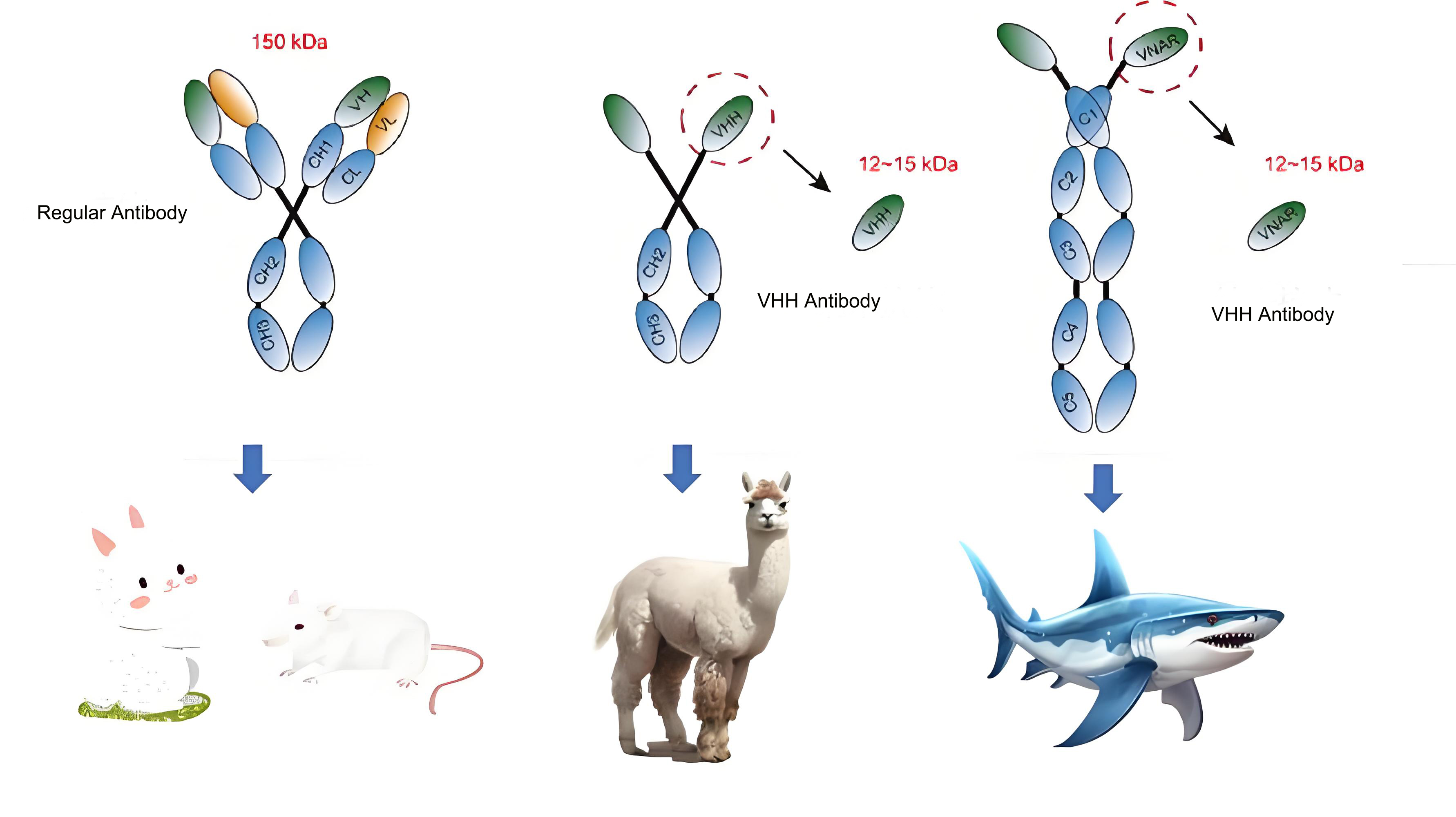Nanobodies, also known as single-domain antibodies (sdAbs), VHH antibodies, or camelid antibodies, are artificially designed antibody molecules and a type of naturally occurring heavy-chain antibodies (HCAbs) found in camelids such as llamas and dromedaries, as well as in cartilaginous fish like sharks and rays.

Discovery and Research Journey
Nanobodies were first reported by Belgian scientists in 1993, who discovered a naturally occurring heavy-chain antibody lacking a light chain in the serum of camels.
Subsequently, scientists cloned a single-domain antibody consisting only of a heavy-chain variable region (VHH), known as a VHH antibody. The crystal structure of the VHH antibody is an elliptical shape of 4 nm x 2.5 nm x 3 nm, with a molecular weight of approximately 12-14 kDa, which is only 10% of the size of a conventional antibody, making it the smallest complete antigen-binding fragment and thus named a nanobody.
Characteristics and Advantages
Small Molecular Weight and Simple Structure: Nanobodies consist of a single immunoglobulin domain, retaining only 10% of the original antigen specificity of a normal IgG, with a molecular weight of approximately 12-15 kDa. They are the smallest naturally occurring fragments that can bind to antigens.
High Stability: Nanobodies have additional disulfide bonds within their structure, allowing them to maintain antigen-binding activity under extreme conditions such as high temperatures and high concentrations of organic solvents. Some nanobodies can be stored at -20°C or 4°C for several months, or even at 37°C for several months to a year without losing their antigen-binding activity.
Strong Solubility and Affinity: Nanobodies have stronger solubility and stability properties, which facilitates their production in different expression systems. They have strong antigen-binding capabilities and can recognize unique antigen epitopes, making it easy to genetically engineer antibodies against different pathogens. Nanobodies can bind to sites that conventional antibodies cannot, with stronger specificity for their targets.
Weak Immunogenicity: Nanobodies lack an Fc region, avoiding Fc-mediated complement reactions, and have weak immunogenicity in humans.
Strong Penetration: Due to their small molecular weight, approximately one-tenth the size of conventional antibodies, nanobodies have stronger penetration ability in animal bodies and tissues, making it easier for them to reach disease tissues that conventional antibodies may not penetrate, thereby exerting a therapeutic effect. Highly permeable nanobodies can enter dense tissues and penetrate the blood-brain barrier.
Easy to Produce: Nanobodies are encoded by a single gene, making them easy to synthesize in microorganisms such as phages and yeast. They can be produced in large quantities in microbial expression systems, and their relatively low cost makes them suitable for large-scale production and easy to popularize and apply. It has been reported that nanobody production can be increased to 1 gram per liter using yeast reactors.
Wide Range of Applications: Nanobodies can be used in biomedical research and development (such as genetic engineering drug development and ADC drug development); in vitro clinical diagnostics (such as colloidal gold methods, enzyme-linked immunosorbent assays, and electrochemiluminescence methods); in basic research on oncology and immunology; and for expanding research ideas and publishing in internationally renowned academic journals.
Application Examples
During the COVID-19 pandemic, the VHH-72 antibody was found to bind tightly to the spike protein of the SARS-CoV-2 virus, thereby preventing viral infection.
Nanobodies can also be used for in vitro and in vivo imaging, making them ideal for disease diagnosis. For example, by specifically recognizing and neutralizing special structural proteins, they can assist the host's immune defense against infections.
In medical diagnosis and treatment, bifunctional or bispecific antibodies can be constructed for targeted therapy of diseases.
Nanobodies have a wide range of applications in the field of food safety testing, including the detection of pesticide and veterinary drug residues, food additives, biotoxins, pathogenic microorganisms, and environmental pollution.
In summary, nanobodies have a wide range of applications in the biomedical field due to their unique structure and excellent properties. With the continuous deepening of research and advancements in technology, nanobodies are expected to play an important role in more areas.
User Comment(Total0User Comment Num)
- No comment


 +86 571 56623320
+86 571 56623320




